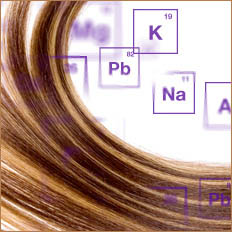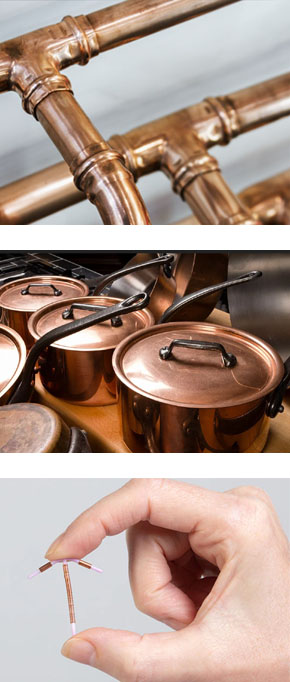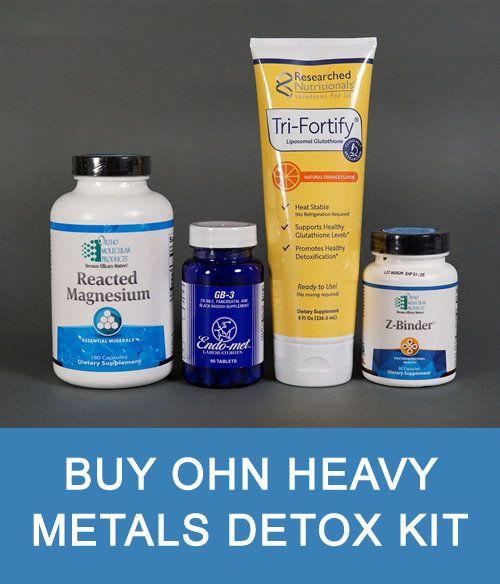Copper Toxicity and Hair Tissue Mineral Analysis
How To Measure Your Body's Heavy Metal Levels
Health Effects of Copper Toxicity
Sources of Excess Copper
Treatment of Copper Toxicity

Many of us are exposed to harmful heavy metals such as lead, mercury, and copper somewhat frequently in our daily lives. It is common to have harmful (poisonous) excesses of these metals in the body without even knowing it.
High levels of toxic metals can negatively impact brain function, cause hormonal imbalances, and generally harm or diminish functioning in your body. The health effects can be very serious.
Unlike many types of drugs, toxic metals don't remain in blood circulation for very long after exposure. This is because the body's detoxification processes remove heavy metals from the blood and deposit them into tissues including your bones, teeth, and hair. Therefore blood tests usually do not work well for testing for heavy metal presence in the body.
Hair Tissue Mineral Analysis (HTMA), on the other hand, can provide you with very valuable information about your body's heavy metal levels as well as mineral imbalances that you may not be able to obtain through other means, including blood tests.
▶︎ Learn More about Hair Tissue Mineral Analysis
Copper Toxicity and Hair Tissue Mineral Analysis
Kristina Amelong, CCT, CNC, discusses the causes and symptoms of copper toxicity and how you can use a hair tissue mineral analysis (HTMA) to discover if your body has high levels of toxic copper and determine the best way to balance your body's minerals.

Health Effects of Copper Toxicity
Copper is naturally present in our bodies as an essential trace mineral and biochemically supports several enzymes that are central to the body's functioning.
Too much copper, however, can become very toxic to the body and result in health consequences including:
- low energy levels and chronic fatigue
- decreased thyroid function
- liver damage
- a weakened immune system
- GI symptoms
- high levels of oxidative stress and free radicals
- hormonal imbalances
- infertility
- neurological issues such as depression and anxiety
Because of the inaccuracy of blood testing, copper toxicity can be difficult to diagnose, despite having such serious health consequences.

Sources of Excess Copper
You may be wondering how one can accumulate enough copper in the body to result in copper toxicity. Copper can be absorbed or ingested from:
Hormonal Factors
High levels of copper and estrogen are often related, as estrogen can increase copper retention and accumulation in the body. Therefore copper toxicity occurs somewhat more frequently in women than in men.
The body's zinc and copper levels are usually inversely correlated, and both are heavily influenced by hormonal factors, specifically estrogen, progesterone, and testosterone. Zinc is involved in the production of progesterone and testosterone, and as mentioned above, copper levels are influenced by estrogen.
HTMA tests include a zinc/copper ratio in the results. A high zinc/copper ratio would indicate elevated testosterone and progesterone levels, while a low ratio would indicate elevated estrogen levels, elevated copper levels, and possible copper toxicity.
▶︎ Learn More about Hair Tissue Mineral Analysis
Treatment
Treatments for copper toxicity can vary, depending on the other significant mineral ratios indicated in your HTMA results.
- Firstly, it's important to determine where the excess copper in your body has come from, and to put an end to those sources — for example, removing your copper IUD, changing your birth control, not drinking water dispensed through copper pipes, giving up cigarettes, eliminating copper cookware, etc.
- Dietary changes can also be important, especially avoiding foods that are high in copper such as almonds, almond milk, spinach, kale, spirulina, cashews, shellfish, chickpeas, mushrooms, dark chocolate, and avocados.

- NEW! OHN Heavy Metals Detox Kit — This kit contains four key supplements, including the two below, to help you detox from toxic heavy metals including copper, mercury, aluminum, and lead.
- Ortho Z-Binder — This is a broad-spectrum, naturally sourced binding formula which supports enhanced clearance of heavy metals from the GI tract. Binders have been used for centuries to treat toxin exposure and play an important role in many detoxification protocols.
- The supplement GB-3 from Endo-Met Laboratories is extremely helpful in enhancing biliary output, which assists in the removal of toxic metals, specifically copper, from the liver.
- Finally, coffee enemas and/or a full enema series can be valuable tools for helping you detoxify and heal from copper poisoning.
Summary
Copper toxicity can be difficult to diagnose, but can have very serious symptoms and a long-term impact on your health if not addressed.
If you think you may have high copper levels or copper toxicity, it's a good idea to do a hair tissue mineral analysis (HTMA) as soon as possible, and if the results indicate high copper levels, work to reduce those levels.
If you have any general questions about the HTMA process or healing from copper toxicity, reach out to us at 608-242-0200 or customerservice@ optimalhealthnetwork.com.
DISCLAIMER: This material is presented for informational purposes only and is not a substitute for medical advice, diagnosis, or prescribing from a licensed healthcare professional. We make no claim or guarantee for cure or relief of any specific symptom, medical condition, or disease when using any of the products or protocols referenced here. Consult with a licensed healthcare professional before altering or discontinuing any current medications, treatment, or care, or starting any diet, exercise, cleansing, or supplementation program, or if you have or suspect you might have a health condition that requires medical attention.
By Kristina Amelong, CCT, CNC
I-ACT-Certified Colon Hydrotherapist
Certified Nutritional Consultant